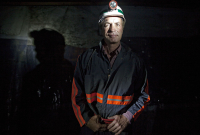Support strong Canadian climate journalism for 2025
2022 was a big year for the environment, especially in Atlantic Canada, where offshore oil projects got approved, hydrogen plans made headlines and an underground coal mine reopened.
Canada’s National Observer delved into Atlantic stories in a way it hadn’t before. Here are our top five stories from the region in 2022.
1. Bay du Nord
This year, the federal government greenlighted Canada’s first deepwater offshore oil project.
When the project was approved in April, Environment and Climate Change Minister Steven Guilbeault said the OK would require the project to achieve net-zero greenhouse gas emissions by 2050, and that the same rule would apply to proposed fossil fuel projects moving forward.
Those opposed to all new fossil fuel development were quick to point out that calling any oil and gas project net zero is misleading. Even if companies could make their products without any emissions, which so far none have, all oil and gas produce emissions when burned.
Looking forward: Yet to be secured is financing for the $16-billion project, and opponents stress the risk that it will become a stranded asset. There is a lawsuit underway arguing the approval of Bay du Nord is unlawful, filed by Ecojustice on behalf of Équiterre and Sierra Club Canada and Mi’gmawe’l Tplu’taqnn Inc., an organization representing eight Mi’gmaq communities in New Brunswick. Also, all eyes are on the new net-zero rule and how it will apply to future projects.
2. The Donkin mine
In September, Canada’s only underground coal mine reopened after shutting down in 2020 following a series of roof falls.
The mine sits on the Atlantic Ocean in Cape Breton. In an investigation, we dove into the dozen roof cave-ins and the pile of safety warnings the mine received from 2017 until its closure in 2020 and the environmental impacts of its reopening. After one full year, the mine is expected to produce enough coal to spew about eight million tonnes of carbon dioxide into the atmosphere when it is burned.
Then, in December, the mine received approval to operate until 2029.
Looking forward: Now that the mine is open, time will tell how the company, Kameron Coal, is or isn’t keeping workers safe. Also, the CBC reported in September that talks were underway between the company and utility NS Power to use some of Donkin’s coal for thermal power. Most of the coal at the site is subsea metallurgical coal, also known as coking coal, used to make steel.

3. Offshore oil exploration
Aside from the approval of Bay du Nord, there has been an explosion in offshore exploration in Newfoundland and Labrador. The province has a plan to double offshore oil production by the end of the decade, so it is encouraging oil companies to find deposits.
This story mapped all oil exploration, production and significant discovery licences as well as areas where companies were invited to bid on projects, and this followup revealed how that uptick is set to put marine life at risk.
In November, the provincial-federal regulator awarded over $238 million worth of exploration licences off the coast of Newfoundland and Labrador.
Looking forward: While exploration licences are a necessary first step for any project, it remains to be seen how many will come to fruition.
4. Hurricane Fiona
September’s hurricane Fiona was the costliest extreme weather event ever recorded in Atlantic Canada. The storm washed at least 20 homes into the ocean, mostly in Port aux Basques on the southwestern tip of Newfoundland. The storm claimed the life of one resident, a 73-year-old woman who was swept out to sea.
So far, estimates have put destruction from Fiona at $660 million in insured damages. However, because most insurance plans don’t cover storm surges, much of the damage to homes and properties will likely not be insured.
There were other impacts, as well. Prince Edward Island’s coastline was significantly washed away, and the Brackley Beach and Cavendish areas of the province’s national park saw their worst damage in almost 100 years during the weekend storm.
Looking forward: As communities rebuild, the question of rebuilding or moving will continue to be a sticky situation. Also, what does Canada need to do to adapt and prepare for extreme weather events?

5. Stories of energy democracy and autonomy
Amid the grim climate-related news, there were also stories about communities finding unique ways to adapt.
In Black Tickle, an Inuit community of 87 residents mostly reliant on diesel for heat, a partnership started offering high-efficiency wood stoves to the community as part of a long-term study on energy autonomy in NunatuKavut.
During hurricane Fiona, one area’s unique grid helped the local utility return power to its community much quicker than most others in Atlantic Canada. Summerside, P.E.I., has an electrical utility owned and operated by the city that’s partly powered by wind and solar. It had most residents back online in two days, while others on the Island and in nearby Nova Scotia were without power for longer stretches.
Notable mentions
Teacher’s fight against glyphosate pitted him against N.B.’s most powerful interests
Protesters pack up with a win after camping in Nova Scotia forest for over 200 days
Last habitat of endangered Atlantic whitefish saved from logging
Thanks for reading in 2022!






Comments